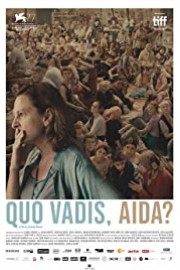Quo vadis, Aida?
The final moments of “Quo vadis, Aida?” are probably the most haunting of any film in 2020. They are not just the culmination of the film, but of a saga of a woman who tried to avert the worst for those closest to her, but in the end, was powerless to do so. Many years later, she has resumed her career as a teacher in the city of Srebrenica, but is unable to find closure, because she knows that those responsible are still around, and many of them have children she is teaching. She is resilient, however, and her strength is what has helped her endure.
I was in high school when the old Bosnian and Serbian states were in chaos, and at the time, it felt like a distant part of the world that was interesting to learn about, but didn’t really have much importance to us in the US, in Georgia. This is where cinema can be the “empathy machine” that Roger Ebert considered it to be, and Jasmila Zbanic’s film brings us up close to the action in a way that is emotionally draining and anxiety inducing. Her film’s protagonist, Aida (played by the riveting Jasna Djuricic), is a translator for the UN forces outside the city of Srebrenica, which has been evacuated by the Serbian army. About 4000-5000 refugees have made it into the UN base where she works, but many more are outside the gates, including her husband and one of their two sons. The UN forces are under strict orders not to let anyone else in, but Aida knows what will happen to them if they are unable to get into the base. The remaining film involves her navigating the tense situation, especially when UN leaders try to negotiate with the Serbian general.
Zbanic’s film is focused on the situation from Aida’s point-of-view, but seeing how diplomacy works when it comes to dealing with the Serbian army, and how the forces on the ground for the UN are hamstrung by the bureaucracy of the organization, is what gives the film an added degree of suspense. She manages to get her family in the base, but when members of the Serbian army are allowed in to search for soldiers that they’ve been fighting, that adds another layer of anxiety to her situation, and it’s a tense scene, which makes her need to keep her family safe all the more urgent. She needs to get them protected. But when they’ve already done her one favor to get them in the base, it’s hard for them to do another one once they are in the base, especially when circumstances change.
For Aida, she sees her position as a translator as a way to survive- and hopefully, protect her family- but for the refugees inside, and outside, of the base, she is seen as a leader, of sorts, or at least an authority figure that might be able to help others. There are times in this film I was reminded of the second half of “Schindler’s List,” where Oscar Schindler is trying to save as many Jews from the Nazis as possible. Aida wants to protect as many of her countrymen as she can, but she knows she’ll only be able to do so much. Her actions throughout the film are admirable, but in the end, she knew she could not be the leader others wanted her to be. In the aftermath, the best she can do is to, maybe, teach the younger generation to be better, even when some of those come from the very people who threatened her family. That’s why the ending is so powerful; she understands the reality, and as wrenching as it might be, she knows she can only move forward when faced with it. That’s all anyone can do when put in such an impossible situation.










